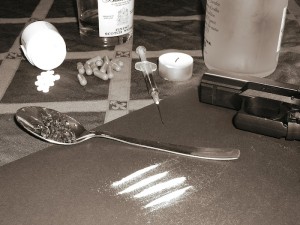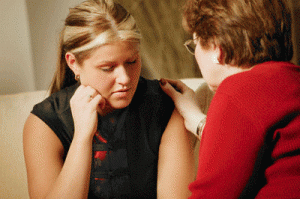Bulimia

Table of Contents
The binging and purging cycle of bulimia may be hard to comprehend if you haven’t personally experienced this eating disorder. Someone who suffers from bulimia alternates between eating large quantities of food (binging) and attempting to purge the food from her system through self-induced vomiting, laxative use, self-starvation or strenuous exercise. Bulimia causes a delusional obsession with body image and a compulsive need for self-control, which is offset by the drive to consume huge quantities of food.
Is it possible to recover from this devastating illness? According to the National Association of Anorexia Nervosa and Associated Disorders, close to 4 percent of the people who have bulimia nervosa will die of the effects of the disease. For the rest, high relapse rates may make recovery seem impossible. However, long-term recovery can be a reality if you seek help from an experienced eating disorder treatment team.
Signs and Symptoms of Bulimia
Dieting and exercising vigorously or using laxatives to control weight are not uncommon in our image-conscious culture, especially among girls and young women. During puberty, girls compare themselves to peers and often find their own bodies “fat” or “ugly” in comparison to their friends. In their 20s, young women may turn to binging and purging to deal with powerful emotions, personal trauma, sexual abuse or low self-esteem. If you are, or a friend or a relative is, binge eating and purging several times a week, you may meet the criteria for bulimia.
- An obsession with body image and weight gain
- A preoccupation with eating, dieting and exercising
- Purchasing large amounts of food — often high-calorie junk foods — that quickly vanish
- Using diuretics or laxatives to avoid gaining weight
- Going to the bathroom immediately after eating
- Weighing oneself repeatedly
- Going through periods of extreme dieting followed by normal eating or overeating
Bulimics are often very secretive about their habits. They will go to great lengths to hide their purging behaviors and may be deeply ashamed of their disorder. A girl who’s binging and purging on a regular basis may hide her body under oversized clothes and refuse to eat in front of friends or family. She may rush off after a meal and disappear for an unusually long period of time, or dispose of her vomit in plastic bags so that the people who share her home don’t see signs of purging in the bathroom.
Bulimics aren’t necessarily underweight or overweight; for many, body weight fluctuates. Although your daughter, sister or best friend isn’t likely to tell you that she’s binging and purging, these physical changes can be a giveaway:
- Bad breath, dry mouth, gum problems or unusual tooth decay
- Broken blood vessels in facial skin, especially around the eyes
- Cuts or scrapes on the knuckles from self-induced vomiting
- Dark circles under the eyes
- Skin rashes
Bulimia is a severe emotional disorder that requires intensive, compassionate treatment. Many people who have bulimia are extremely unhappy with their bodies and despise themselves for what they perceive as a lack of self-control. They may have undiagnosed depression or anxiety disorders that prevent them from having a healthy body image and leading the full life they deserve.
Who Is Affected by Bulimia?
The National Institute for Mental Health (NIMH) estimates that 0.3 percent of the American population has displayed symptoms of bulimia nervosa in the past 12 months. The condition is most prevalent in females, and the average age when the disorder begins is 20. After the age of 60, the number of people afflicted with this disorder decreases dramatically.
More than any other segment of the population, teenage girls and young women experience pressure from the media and from peers to achieve an unrealistic body weight. Not every young girl who goes on a diet or who worries about her weight will get caught in the destructive cycle of binging and purging. But a certain percentage of girls will take dieting to the extreme or go to drastic measures to rid their body of unwanted calories.
Side Effects and Health Consequences

Someone with bulimia may consume thousands of calories in one binging episode. Yet the National Institutes of Health cautions that binging and purging can cause serious health complications, such as:
- Gum disease
- Cavities
- Dehydration
- Constipation
- Damage to the lining of the throat
- Electrolyte imbalances
- Heart failure
Upon entering a rehabilitation program, a complete medical and psychological evaluation is necessary to assess the client’s medical status.
Once your treatment team has evaluated your health condition, they’ll work with you to develop a treatment plan that will help you restore your physical and emotional well-being.
Bulimia and Substance Abuse
 For a lot of young women, bulimia goes hand in hand with substance abuse. Binging behavior may carry over into binge drinking, which only reinforces the bulimic’s concerns about calories and weight gain. In a study published in Psychiatric Times, 31 percent of women who received treatment for bulimia nervosa reported that they had a history of abusing alcohol. Cocaine, marijuana and prescription medications were also commonly abused by the study group. Substance abuse may occur in response to a co-occurring mental health concern or as a way to cope with the same stressors that cause the eating disorder.
For a lot of young women, bulimia goes hand in hand with substance abuse. Binging behavior may carry over into binge drinking, which only reinforces the bulimic’s concerns about calories and weight gain. In a study published in Psychiatric Times, 31 percent of women who received treatment for bulimia nervosa reported that they had a history of abusing alcohol. Cocaine, marijuana and prescription medications were also commonly abused by the study group. Substance abuse may occur in response to a co-occurring mental health concern or as a way to cope with the same stressors that cause the eating disorder.
Stimulants like cocaine or amphetamines may be part of the bulimic’s secret toolkit for maintaining a low weight.
Even over-the-counter medications like diet pills and laxatives can be abused in the effort to control caloric intake. Treatment for bulimia must address addictions or co-occurring mental health disorders in order for rehab to bring long-lasting results.
Recovery Strategies for Bulimia
 A treatment plan for bulimia should draw from a number of different disciplines. Nutritional counseling and supplementation are often necessary to make up for months or years of purging. Behavioral modification methods such as cognitive behavior therapy (CBT) or dialectical behavior therapy (DBT) can be used to help you or your loved one break the destructive cycle of bulimia. The American Journal of Psychiatry reports that dialectical behavior therapy, which targets the powerful emotions that drive bulimic behavior, may be even more effective than cognitive behavior therapy at helping young women recover from this disease.
A treatment plan for bulimia should draw from a number of different disciplines. Nutritional counseling and supplementation are often necessary to make up for months or years of purging. Behavioral modification methods such as cognitive behavior therapy (CBT) or dialectical behavior therapy (DBT) can be used to help you or your loved one break the destructive cycle of bulimia. The American Journal of Psychiatry reports that dialectical behavior therapy, which targets the powerful emotions that drive bulimic behavior, may be even more effective than cognitive behavior therapy at helping young women recover from this disease.
Group therapy plays an important role in recovery from bulimia. In a support group, you can share your personal experiences with your peers, possibly for the first time. Talking with others who have the same disorder may help you overcome the frustration, shame and depression of living with this emotional illness. Family counseling or partners therapy can help your loved ones understand the sources of your disorder. After rehab, many clients go home to a more stable, supportive family environment thanks to group counseling for families and couples.
Medication is frequently used in conjunction with psychotherapy to control the compulsive habits of bulimia. Antidepressants may be prescribed to help you deal with the emotions that surround binging and purging. Antidepressants can be combined with other medications to help you control binging behavior.
Confronting a distorted body image and learning to eat normally without fear are key goals for a bulimia recovery program. In a supportive residential setting, you can become aware of the triggers that drive you to binge and purge and learn how to cope with those triggers in a positive way. Nutritious meals, recreational activities and relaxation therapy can help you feel healthy and whole again. If you’re struggling with bulimia or you’re close to someone who shows signs of this condition, contact us for information on our comprehensive treatment plans for eating disorders.

